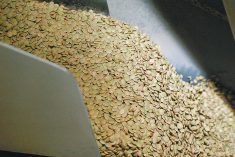Prairie grain growers have managed to shake off the worst of the shocking sell-off in U.S. grain prices, but it’s for a bad reason and might not last.
Acreage of durum, barley and some other prairie crops has been so badly ravaged across the Canadian Prairies and in North Dakota that those crops’ prices have stopped following corn.
“We have a different supply and demand situation,” said Agri Trend Marketing manager Derek Squair.
Barley, durum and feed wheat cash prices have remained firm on the Prairies regardless of the slump in U.S. corn and wheat futures.
Read Also

Anti-separatist movement targets rural Alberta
Former deputy premier Thomas Lukaszuk’s anti-separatism Alberta Forever Canada petition campaign expects to run full steam ahead into the province’s farming regions
“The short term cash value hasn’t changed.”
Brokers and analysts report high barley and feed wheat prices as last year’s short crop becomes shorter. The new crop has lost acreage and faces harvest losses.
As well, durum prices are strong, with the Canadian Wheat Board boosting most qualities and grades by more than $2 per bushel in the June Pool Return Outlook. Number one CWAD with 13 percent protein has increased to $11.78 per bushel from $9.63 per bu.
At the same time, corn futures in Chicago collapsed after the U.S. Department of Agriculture released its June seeded acreage and stocks reports.
They found that U.S. farmers managed to seed 1.7 percent more acres to corn than most analysts expected, and that stocks of corn in the United States were significantly larger than expected.
Corn futures were down the 30-cent limit June 30, the day of the report’s release, and new crop months were also down sharply July 1. Wheat was sucked along in the downdraft, as was oats. Soybeans avoided most of the slump, while canola fell two percent.
December 2011 corn’s slump from a mid-June peak of $7.20 per bushel to below $6 has knocked back the strongest crop of 2011 to below a key winter resistance level.
There was a gap on the charts between pre-USDA $6.20 to below $5.90 on the release day.
However, soybeans have not fallen out of their range, and canola is still within the price range it has inhabited throughout 2011.
Prairie and North Dakota growing conditions don’t have a big impact on world corn and soybean production, but they can have a major impact on world supplies of quality spring wheat, durum, canola, barley and special crops.
Farmers’ failure to seed millions of acres and the lateness of the crop have allowed prairie-dominated crops to hang onto high cash prices regardless of the slump in grain futures.
That’s led to unusual price spreads in the prairie feed grains market. The feedlot region of southern Alberta has seen feed grain prices well below southern Manitoba prices.
Manitoba prices are often low because of the usually huge supply of U.S. corn just south of the border, but they have increased now that U.S. corn is extremely tight and millions of acres are unseeded.
Doug Chambers of Quality Grain in Calgary said feed wheat in southern Manitoba is selling at a $1.50 premium to prices in southern Alberta, and barley is 50 cents per bushel richer in Manitoba.
“There’s a huge spread between the Manitoba and Alberta markets,” said Chambers.
He said the present resoluteness of cash grain prices on the Prairies can last for some time because commercial users need to ensure supplies.
“At this point, (the USDA report) means nothing,” he said.
“But in the long run, if futures prices continue lower, we definitely will see a back-off in feed prices”
Still, 2011-12 will likely see continuing high feed prices as prairie feed grain remains tight because of two years of seeding problems.
“There’s just not enough good feed out there,” said Chambers.
Squair said livestock feeders will be squeezed in 2011-12 as high quality feed grain is gobbled up and they either have to raise bids or bring in feed from elsewhere.
“We’ll run out of higher quality feed,” he said.















